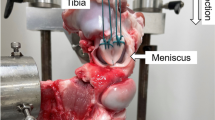Abstract
Introduction
Cannulas used with suture based meniscal repair techniques can potentially injure the load transmitting fibers of the meniscus. The subject of this study was to quantify this effect in a porcine in vitro model.
Materials and methods
From fresh frozen medial porcine menisci tissue specimens were harvested following the course of the peripheral circumferential fibers bundles. In the first part of the study the tissue samples were perforated with the cannulas of either a Fast Fix or a Rapidloc device or with an 18-gauge needle. The specimens were then visually inspected for fiber damage using low power microscopy and the mean size of the laceration was measured. Finally, the extent of the tissue laceration was indirectly determined using non-contact strain measurements of the samples before and after puncture.
Results
When advanced with the cutting edge perpendicular to the fibers, the cannulas consistently cut the fibers while those were rather separated with the opposite orientation. It could be shown that specimens with a mean width of 8.1 mm lost 25% of the load transmitting cross section when being perforated two times with a Fast Fix device (P < 0.001). This effect is negated when the cannula was oriented in line with the fibers.
Conclusions
Cannulas used for suture based meniscal repair can cause a substantial laceration of the meniscal tissue. The effect strongly depends on the orientation of the cutting edge of the cannula relative to the course of the fibers and can thus potentially be avoided by an appropriate handling and design.





Similar content being viewed by others
References
Anderson K, Marx RG, Hannafin J, Warren RF (2000) Chondral injury following meniscal repair with a biodegradable implant. Arthroscopy 16:749–753
Aspden RM, Yarker YE, Hukins DW (1985) Collagen orientations in the meniscus of the knee joint. J Anat 140(Pt 3):371–380
Becker R, Schroder M, Starke C, Urbach D, Nebelung W (2001) Biomechanical investigations of different meniscal repair implants in comparison with horizontal sutures on human meniscus. Arthroscopy 17:439–444
Becker R, Starke C, Heymann M, Nebelung W (2002) Biomechanical properties under cyclic loading of seven meniscus repair techniques. Clin Orthop 236–245
Boenisch UW, Faber KJ, Ciarelli M, Steadman JR, Arnoczky SP (1999) Pull-out strength and stiffness of meniscal repair using absorbable arrows or Ti-Cron vertical and horizontal loop sutures. Am J Sports Med 27:626–631
Borden P, Nyland J, Caborn DN, Pienkowski D (2003) Biomechanical comparison of the Fast-Fix meniscal repair suture system with vertical mattress sutures and meniscus arrows. Am J Sports Med 31:374–378
Dervin GF, Downing KJ, Keene GC, McBride DG (1997) Failure strengths of suture versus biodegradable arrow for meniscal repair: an in vitro study. Arthroscopy 13:296–300
Fithian DC, Kelly MA, Mow VC (1990) Material properties and structure–function relationships in the menisci. Clin Orthop Relat Res 19–31
Fox JM, Rintz KG, Ferkel RD (1993) Trephination of incomplete meniscal tears. Arthroscopy 9:451–455
Jones RS, Keene GC, Learmonth DJ, Bickerstaff D, Nawana NS, Costi JJ, Pearcy MJ (1996) Direct measurement of hoop strains in the intact and torn human medial meniscus. Clin Biomech 11(5):295–300
Menetrey J, Seil R, Rupp S, Fritschy D (2002) Chondral damage after meniscal repair with the use of a bioabsorbable implant. Am J Sports Med 30:896–899
Miller MD, Kline AJ, Gonzales J, Beach WR (2002) Pitfalls associated with Fast-Fix meniscal repair. Arthroscopy 18:939–943
Narmoneva DA, Wang JY, Setton LA (1999) Nonuniform swelling-induced residual strains in articular cartilage. J Biomech 32(4):401–408
Newman AP, Anderson DR, Daniels AU, Dales MC (1989) Mechanics of the healed meniscus in a canine model. Am J Sports Med 17:164–175
Petersen W, Tillmann B (1998) Collagenous fibril texture of the human knee joint menisci. Anat Embryol (Berl) 197:317–324
Provenzano PP, Hayashi K, Kunz DN, Markel MD, Vanderby R Jr (2002) Healing of subfailure ligament injury: comparison between immature and mature ligaments in a rat model. J Orthop Res 20:975–983
Provenzano PP, Hurschler C, Vanderby R Jr (2001) Microstructural morphology in the transition region between scar and intact residual segments of a healing rat medial collateral ligament. Connect Tissue Res 42:123–133
Provenzano PP, Vanderby R Jr (2006) Collagen fibril morphology and organization: implications for force transmission in ligament and tendon. Matrix Biol 25:71–84
Rankin CC, Lintner DM, Noble PC, Paravic V, Greer E (2002) A biomechanical analysis of meniscal repair techniques. Am J Sports Med 30:492–497
Rankin M, Noyes FR, Barber-Westin SD, Hushek SG, Seow A (2006) Human meniscus allografts’ in vivo size and motion characteristics: magnetic resonance imaging assessment under weightbearing conditions. Am J Sports Med 34:98–107
Song EK, Lee KB (1999) Biomechanical test comparing the load to failure of the biodegradable meniscus arrow versus meniscal suture. Arthroscopy 15:726–732
Sweigart MA, Athanasiou KA (2005) Biomechanical characteristics of the normal medial and lateral porcine knee menisci. Proc Inst Mech Eng [H] 219:53–62
Sweigart MA, Zhu CF, Burt DM, deHoll PD, Agrawal CM, Clanton TO, Athanasiou KA (2004) Intraspecies and interspecies comparison of the compressive properties of the medial meniscus. Ann Biomed Eng 32:1569
Thornton GM, Leask GP, Shrive NG, Frank CB (2000) Early medial collateral ligament scars have inferior creep behaviour. J Orthop Res 18:238–246
Walsh SP, Evans SL, O’Doherty DM, Barlow IW (2001) Failure strengths of suture vs. biodegradable arrow and staple for meniscal repair: an in vitro study. Knee 8:151–156
Author information
Authors and Affiliations
Corresponding author
Additional information
This study is a Winner of the AGA DonJoy award 2006.
Rights and permissions
About this article
Cite this article
Staerke, C., Kopf, S. & Becker, R. The extent of laceration of circumferential fibers with suture repair of the knee meniscus. Arch Orthop Trauma Surg 128, 525–530 (2008). https://doi.org/10.1007/s00402-007-0533-2
Received:
Published:
Issue Date:
DOI: https://doi.org/10.1007/s00402-007-0533-2




